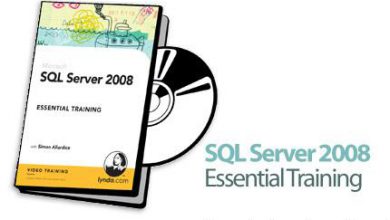Topics include:
– Installing or upgrading to Windows 10
– Connecting to the Internet
– Launching, quitting, and managing applications
– Creating, copying, moving, and renaming files and folders
– Zipping and unzipping files
– Using Cortana to search
– Browsing the web with Edge
– Sending email
– Installing new apps
– Sharing files over home networks
– Backing up and restoring files
– Configuring Windows updates
– Using Windows Defender
Windows 10 New Features:
Windows 10 is here! Explore the core new features and improvements in Microsoft’s newest operating system. Take a look at the Start menu, Task View, Snap Assist, and Continuum, which allows you to run the same apps on mobile Windows devices as your PC. Also see how the Cortana virtual assistant can help you find files and more, and check out the the Edge web browser’s novel capabilities.
Topics include:
– Introduction
– The Start menu
– Unified Settings and Control Panels
– The Task View
– Continuum
– Cortana
– Snap Assist
– Microsoft Edge browser
– Conclusion
Windows 10: Configure and Support Core Services
In case some of the steps involved in a Windows 10 installation aren’t intuitive, this course shows various ways to change the configuration of default services. Follow Joli Ballew as she covers networking, storage, data access and usage, and Remote Management. Plus, she shares how to implement Windows Store apps and Windows Store for Business, as well as the Windows Assessment and Deployment Kit, which you’ll want to get familiar with if your job involves deploying Windows 10. This course maps to the domain of Exam 70-698, Installing and Configuring Windows 10, a required exam for Microsoft Certified Solutions Associate (MCSA).
Topics include:
– Configuring and supporting network settings
– Connecting to a network and configuring network locations
– Using Windows Firewall
– Managing partitions with Disk Management
– Managing storage with PowerShell
– Creating and configuring a VHD
– Creating and configuring homegroups and folder shares
– Configuring desktop apps and startup options
– Creating and deploying provisioning packages
– Using Remote Management tools
– Configuring Remote Assistance and Remote Desktop
Windows 10 Creators Update Training
Learn the essentials of the Windows 10 operating system, including the features included with the Creators Update. In this comprehensive course, Nick Brazzi shows how to install Windows 10, work with bundled applications, manage files and folders, use Cortana to search, browse the web with Edge, and work with mail, calendar, and your contacts. Want to extend Windows? Learn how to find and install new apps from the Windows Store and customize your display preferences and account settings so your PC suits your unique needs. Finally, find out how to back up and restore Windows in case of computer failure, recover missing files, and protect yourself against malware such as viruses and spyware.
Topics include:
– Running Windows 10 for the first time
– Launching applications
– Interacting with windows, menus, and ribbons
– Multitasking to switch between multiple applications
– Switching to Tablet mode
– Browsing and managing files and folders with the File Explorer
– Browsing the web with Edge
– Working with email, contacts, and calendars
– Using and installing apps
– Managing display and account settings
– Searching with Cortana
– Sharing with home networks
– Backing up Windows 10
– Troubleshooting Windows 10
Windows 10: Deploy and Manage Virtual Applications
Application virtualization with App-V centralizes the configuration and deployment of Windows apps, while eliminating software conflicts. This hands-on course covers the skills necessary for a system admin to deploy and manage virtual apps in Windows 10. Microsoft MVP Brien Posey covers installing and configuring App-V, sequencing an application, editing and upgrading a virtual application, and deploying virtual applications. Plus, learn about deploying desktop and mobile apps via Intune. This course also maps to the corresponding domain within the Microsoft exam 70-696, Administering System Center Configuration Manager and Intune, and will help you prepare for MCSE certification.
Topics include:
– Installing and deploying App-V
– Sequencing an application
– Editing or upgrading an application
– Configuring applications for deployment in App-V
– Deploying apps with Intune
Windows 10: Plan and Implement Software Updates
Software updates are key to keeping the systems on your network current and secure. Learn how to plan and implement software updates in Windows 10, while you prepare for Microsoft exam 70-696, Administering System Center Configuration Manager and Intune. Microsoft MVP Brien Posey shows how to deploy and manage updates using three different services: Software Center Configuration Manager (SCCM), Windows Server Update Services (WSUS), and Intune. He covers topics such as creating update groups in Configuration Manager, approving and declining updates in Intune, deploying Microsoft and non-Microsoft updates in Intune, configuring automatic deployment rules, and analyzing log files to troubleshoot problematic updates.
Topics include:
– Deploying updates manually
– Monitoring deployments
– Configuring automatic deployment rules
– Analyzing log files
– Approving and declining updates in Intune
– Deploying software from SCCM, WSUS, and Intune
Windows 10: Provision and Manage Mobile Devices
Take control of mobile. Learn how to use ActiveSync policies, System Center Configuration Manager (SCCM) profiles, and Intune to control the way your mobile users access email, Wi-Fi, VPN, apps, and data. This hands-on course covers the skills system administrators need to provision and manage mobile devices in Windows 10. Microsoft MVP Brien Posey shows how to connect mobile devices to Exchange Server and Exchange Online, provision user accounts for Intune, connect Intune with SCCM, configure Intune for mobile device management, and manage devices and conditional access in Intune.
This course also maps to the corresponding domain within the Microsoft exam 70-696, Administering System Center Configuration Manager and Intune, and will help you prepare for MCSE certification.
Topics include:
– Configuring mobile device mailbox policies in Exchange
– Viewing mobile device information
– Managing ActiveSync policies with Configuration Manager
– Configuring profiles: VPN, certificate, email, and Wi-Fi
– Configuring Intune for mobile device management
– Enrolling mobile devices in MDM
– Managing devices with Intune
Windows 10: Plan Desktop and Device Deployment
Demonstrate your fundamental understanding of Windows 10 by taking Microsoft Certification exam 70-697, Configuring Windows Devices. The 70-697 exam is a requirement for obtaining an MCSA: Windows 10 certification. This hands-on, practical course covers the skills necessary for a system admin to plan deployments in Windows 10—and prepare for the Plan Desktop and Device Deployment domain of Microsoft Certification exam 70-697. Brien Posey shows how to perform a migration from Windows 7 to Windows 10, enable and configure Hyper-V, configure mobility options, and work with power plans. Plus, he explains how to encrypt a drive using BitLocker. Review the learning objectives for the Plan Desktop and Device Deployment domain of exam 70-697 at https://www. microsoft. com/en-us/learning/exam-70-697. aspx.
Topics include:
– Migrating and configuring user data
– Collecting files and settings from a source computer
– Restoring files to a destination computer
– Configuring Hyper-V
– Creating and managing a virtual switch
– Modifying a virtual machine
– Configuring mobility options
– Working with the Windows Mobility Center
– Configuring security for mobile devices
– Encrypting a drive
Windows 10: Troubleshooting for IT Support
Windows 10 is the most secure and reliable operating system ever from Microsoft. But when things go wrong, your users need your help to troubleshoot their issues. In this course, instructor Andrew Bettany provides a comprehensive guide to troubleshooting a range of Windows 10 issues commonly encountered by IT professionals—especially help desk professionals tasked with user support. Learn how to remotely help your users, troubleshoot hardware and software, and restore Windows 10 should you need to. You can discover how to resolve user account and permissions issues, and troubleshoot file access, networking and Wi-Fi problems, and Windows 10 startup issues. Plus, learn how to resolve app incompatibilities, diagnose and fix performance bottlenecks. Andrew wraps up the course with a look at essential maintenance tasks that will keep Windows 10 users from encountering problems in the first place.
Topics include:
– Enterprise desktop support skills and traits
– Remote troubleshooting
– Troubleshooting hardware and device issues
– Using System Restore
– Securing user accounts
– Resolving networking issues
– Managing files and disks
– Troubleshooting sharing and file access issues
– Resolving app compatibility
– System resource issues: RAM, CPU, and more
– Essential Windows 10 maintenance
– Windows 10 startup issues





